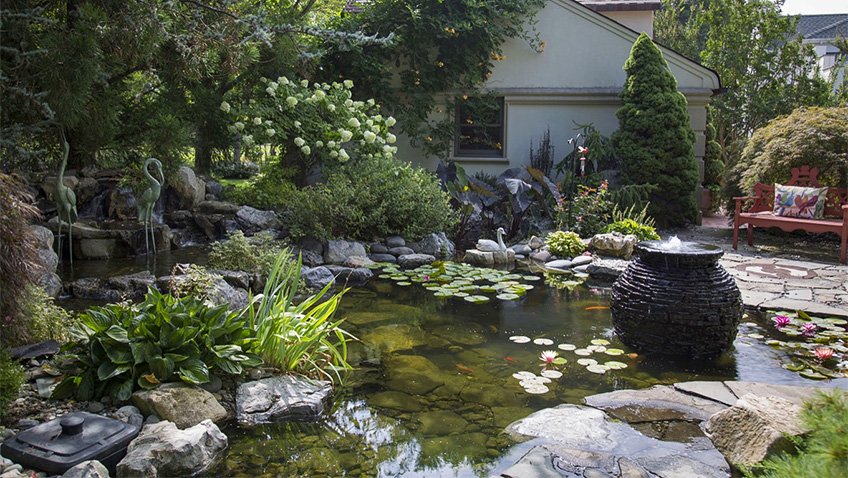Do you have a pond in your garden? Either as an ornamental feature, or if you are lucky enough to have a large garden, as an integral part of your garden landscape?
If you do then autumn, which is now upon us, is the ideal time to do some pond cleaning and maintenance: getting your pond ready for winter and ensuring that it remains a healthy feature into next year and beyond.
Because ponds are full of living organisms – such as plants, fish and other water creatures –it’s inevitable that from time to time they need maintenance and a clear up, just like any other part of your garden would. Ponds can often be surrounded by trees and in the autumn the pond’s surface can become covered by fallen leaves that eventually add to the silt at the bottom of the pond.
So, if you have a pond here are some of the things you should do at this time of year to keep it in a good healthy condition.
Cleaning your pond
Ponds should be given a full clean once every five years and if you are planning to give your pond a full clean this year he first thing you will need is a holding tank. Place this in a shady spot if possible and as near to the existing pond as you can.
The next stage is to drain the pond. You have two choices here, you can either drain it completely or just take out sufficient water to allow you to undertake the cleaning and maintenance work that’s needed. Again, this will depend of the size of the pond and the level of maintenance and cleaning that you want to undertake. The quickest and easiest way to drain the pond is to use a pump. You can also do this by hand if you wish but it can be a laborious and tiring job.
As you are draining the pond look out for fish and other water based creatures, carefully net them and place them in the holding tank, ready to return to the pond when you have finished cleaning.
Thin out pond weed
The plants in your pond are likely to be in baskets, pots or free floating. If you are thinning out the pond weed it is best to pile it on the side of the pond for 24 hours or so after lifting. This will allow time for any “water creatures” that may be tangled or hiding in the weed to make their way back to the safety of the pond itself.
As you lift the plants that are in baskets or pots then you need to check and see whether they would benefit from either re-potting or dividing if they have outgrown their existing containers. Water lilies in particular will need dividing every few years as in the right conditions they can be quite vigorous growers.
Remove silt
Once you have drained the pond to a suitable depth and taken out the pond weed and other plants it’s time to turn your attention to the silt at the bottom – after all it’s really this that needs to be removed on a regular basis because if left it can cause harm to the ponds eco-system and cause the water to become discoloured.
You need to remove about 90% of what is in the pond, leaving around 10% in there as this will help to retain and re-establish many of the tiny organisms that live in the silt and provide food for the fish and other creatures that inhabit the pond. But whatever you do, don’t throw this silt away – it is highly nutritious and makes great compost for your garden so use it on your flower beds.
Clean the liner
The next job is to clean the liner by scrubbing with a brush, making sure you remove all or as much of the algae as you can. Use water from a bucket and then when finished throw this on your garden – whatever you do, don’t put it back in the pond!
When the liner is cleaned then you’re just about done. You just need to turn your attention to any water feature or fountains you may have. Give this a good inspection, make sure that it is in good working order and that no maintenance is needed. Also make sure that the pipes that feed it with water from the pond are not restricted in any way and clean out any debris that may have collected in it.
Final steps
The final steps then are to return the retained silt to the bottom of the pond. Then place baskets of water lilies and other plants where you want them. A good tip with water lilies is to place them away from the water feature if at all possible because the calmer the water they are planted in the better it is for the plant. You then need to re-fill the pond slowly, preferably with rain water if you have water buts, but if not then from the tap.
Once the pond has been re-filled you should leave it for at least 48 hours before you re-introduce your fish. This will give the water enough time to settle down, and if you have used tap or treated water it will allow time for the chemicals, such as chlorine, that can be harmful to the fish to have evaporated. It also ensures an even temperature throughout the water itself. You can then re-introduce your fish, sit back, admire your handy work and be safe in the knowledge that your pond and fish are set fair for winter and beyond!




